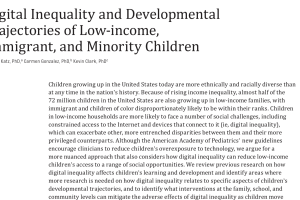Abstract
Children growing up in the United States today are more ethnically and racially diverse than at any time in the nation’s history. Because of rising income inequality, almost half of the 72 million children in the United States are also growing up in low-income families, with immigrant and children of color disproportionately likely to be within their ranks. Children in low-income households are more likely to face a number of social challenges, including constrained access to the Internet and devices that connect to it (ie, digital inequality), which can exacerbate other, more entrenched disparities between them and their more privileged counterparts. Although the American Academy of Pediatrics’ new guidelines encourage clinicians to reduce children’s overexposure to technology, we argue for a more nuanced approach that also considers how digital inequality can reduce low-income children’s access to a range of social opportunities. We review previous research on how digital inequality affects children’s learning and development and identify areas where more research is needed on how digital inequality relates to specific aspects of children’s developmental trajectories, and to identify what interventions at the family, school, and community levels can mitigate the adverse effects of digital inequality as children move through their formal schooling. On the basis of the evidence to date, we conclude with guidelines for clinicians related to supporting digital connectivity and more equitable access to social opportunity for the increasingly diverse population of children growing up in the United States.
The United States hit a demographic milestone in July 2011: the majority of infants born that month were nonwhite for the first time in the nation’s history.1 Population diversity within the next generation is on the rise; 25% of US children are Hispanic,2 14% are non-Hispanic African American, and 5% are non-Hispanic Asian American.3 Furthermore, the share of US children who are either immigrants or the US-born children of immigrants, of any origin, grew from 18% to 25% between 1994 and 2014.
This article was published in a special 2017 supplement of Pediatrics, a journal of the American Academy of Pediatrics. The supplement, “Children, Adolescents and Screens: What We Know and What We Need To Learn,” was produced by Children and Screens and includes the contributions of more than 130 interdisciplinary authors across 22 papers. See a complete list of articles included in the supplement.
